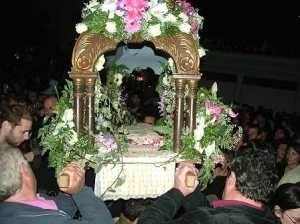While I would not wish to argue that Greek Orthodoxy is in any way a “feminist” tradition, the shadow of the Goddess falls long over the two great festivals of spring and midsummer.
In Greek Othodox tradition, there are two major spiritual holidays–Easter in the spring and the Dormition/Assumption of the Virgin at midsummer. The Panagia, She Who is All Holy, also known as Mother of God, Virgin, and Mary, is a central figure in people’s faith–dethroned neither by the Reformation nor by Vatican II. Indeed when I speak of the need for the “rebirth of the Goddess” in Greece, I am often told, “the Panagia is our Goddess.” This may not be theological orthodoxy, but it expresses a truth of practice.
In Greek Orthodoxy, the birth of Christ, while celebrated along with the arrival of the Kings in early January, was not a central holiday until the coming of capitalist consumption only a few decades ago. The real celebrations of the Greek year are at Easter and on August 15. These are the times when families gather in their ancestral homes.
The Greek Easter celebrations are called the “Divine Drama,” and the reference to Greek tragedies is clear. The highlight of the Easter celebrations for many is not the resurrection, which happens at midnight Saturday, but the death of Christ which is experienced on Friday night. On Thursday and Friday nights the women of my village enter into a state of mourning as intense as if it were their very own sons who died. When I first witnessed this, I was puzzled and slightly horrified.
Now I have come to see women as major and perhaps the central players in the Divine Drama. For the four Fridays before Holy Week begins, the liturgy is dedicated to the “Saying Goodbye” of Mary to her son. Though they are prohibited from uttering the holy words reserved to the male clergy, on Fridays the women express their identification with the suffering of Mary, which helps them cope with the losses in their own lives.
Women come to fore again on Holy Thursday night when the icon of Christ is hung on the cross. After going home to change their clothes, the women return to the church to perform an all-night vigil, during which they decorate the coffin into which the icon of Christ will be placed. Traditionally the coffin was decorated with spring wildflowers collected from the fields.
The priests are home sleeping during the women’s vigil, but return to the church in the morning to take the body down from the cross, where it is placed in the coffin or “tafos” the women have lovingly prepared. On Friday night, the coffin and its tabernacle, or “epitafios,” is paraded through the streets. The priests are followed by women (and men and children) who sing songs of death.
(Read the rest of the essay Here, Feminism and Religion.)
Carol P. Christ is a founding mother in the fields of women and religion and feminist theology. Her books include She Who Changes and Rebirth of the Goddess and the widely used anthologies Womanspirit Rising and Weaving the Visions. One of her great joys is leading Goddess Pilgrimages to Crete through Ariadne Institute. She has lived half of her adult life in Greece and is a dual citizen and bi-cultural hybrid.


Reblogged this on ejournalofmago.